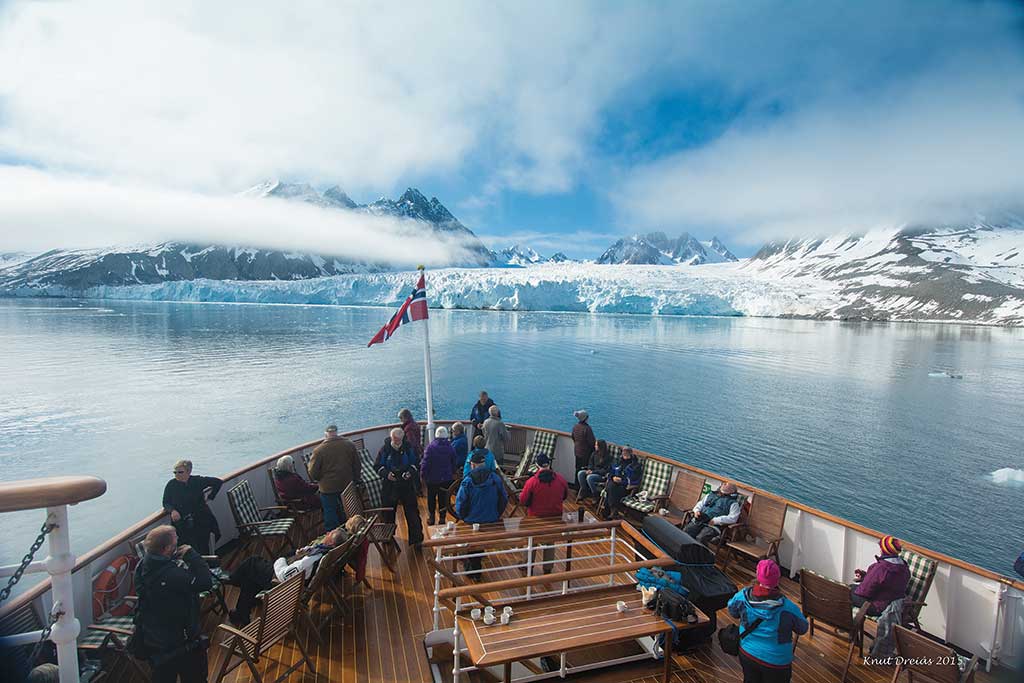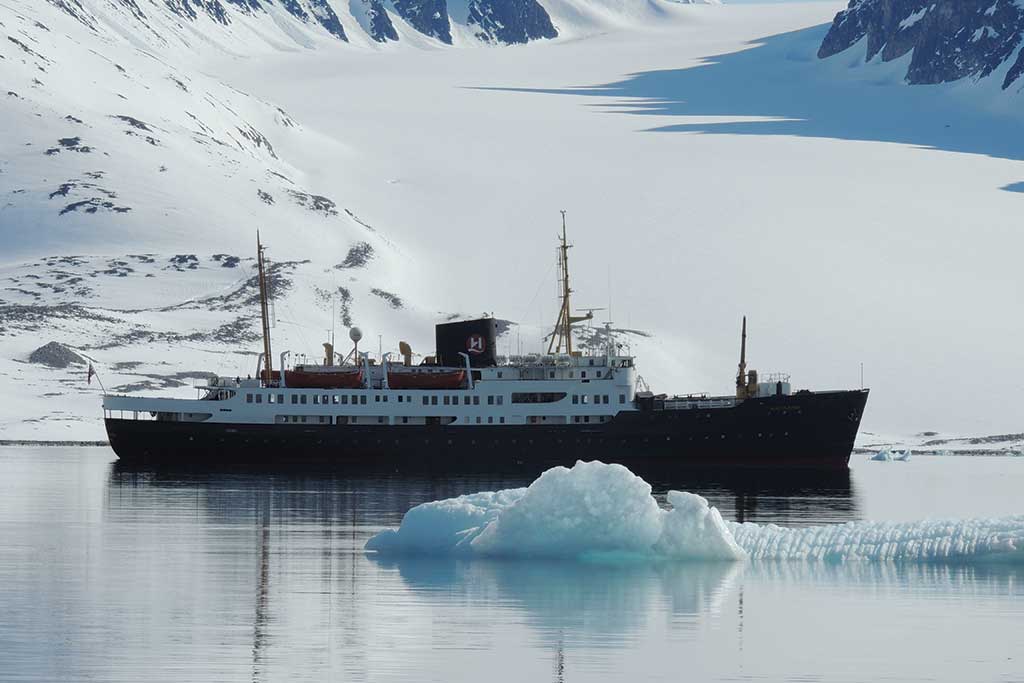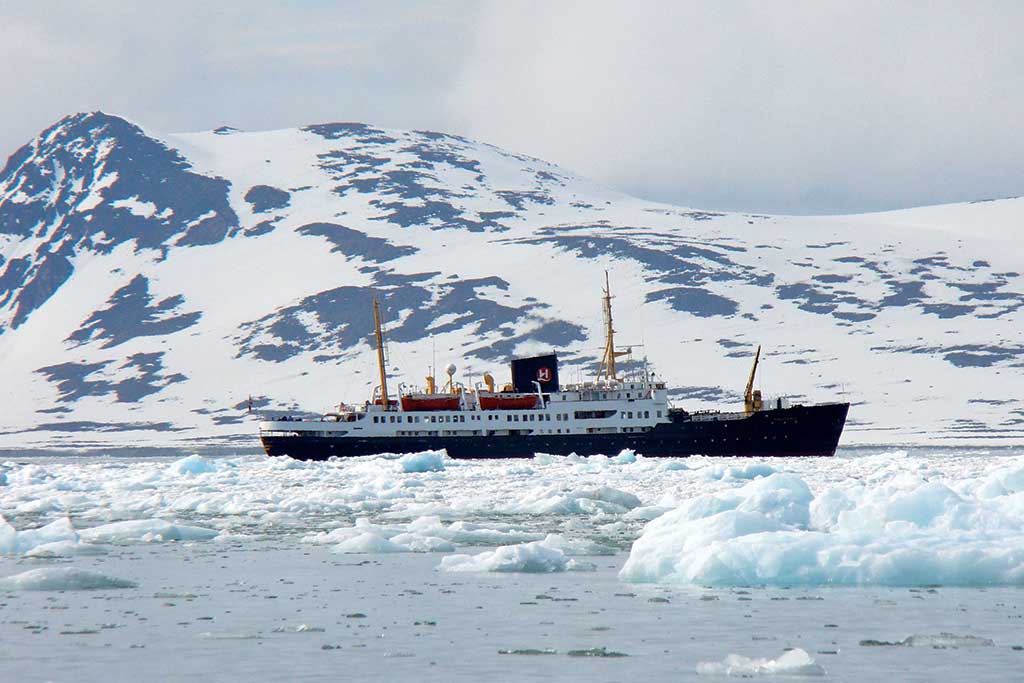I first stop at the small, but brilliantly laid out Svalbard Museum (www.svalbardmuseum.no). It helps put Svalbard into perspective for me. Svalbard’s history as an industry mecca for whalers, miners, and trappers, as well as the archipelago’s place as an important location in Arctic exploration, are viewed through artifacts and detailed storytelling panels. This allows guests to see how man tried to conquer this extreme landscape with varying degrees of success. Eerie supplies, clothes, and other knick-knacks are displayed from failed early exploration efforts providing an all-too-real account of the dangers of Svalbard. The star of the museum is the illuminated walkway that shows the land’s biodiversity. Speckled microorganisms designed to survive the freezing temperatures to reindeer all play their part in keeping balance in this land of extremes. Besides the museum exhibits, be sure to have a look at the gift shop with a ton of hard-to-find books about the land (both non-fiction and fiction) and some local crafts, including Svalbard-designed knitwear.
I also visit the Galleri Svalbard (www.lokalstyre.no) and first enjoy the rotating exhibitions, including an impressive collection of historical maps. I particularly enjoy the original Arctic maps that show beautifully hand-drawn sea creatures and polar bears that early explorers thought to be tremendously exaggerated beasts. The gift shop has copies of a lot of the work on display, but also a huge amount of locally made art and handicrafts (coal earrings anyone), and works by some of the world’s most famous nature photographers. I can’t wait to see more of this land and what they were inspired by.

Later that afternoon, I get picked up at the hotel for a kayak trip with Spitsbergen Travel (www.spitsbergentravel.com), and I am immediately anxious when I see that I am with a very fit German family who look like they raided their local REI store for waterproof outerwear. An American couple doesn’t ease my feelings when they jokingly say: “We thought we were unprepared!” and tap me on the shoulder. To my credit, I am toasty in my Victorinox fleece jacket. Luckily, we all get to change into survival suits (a half-hour process), and I am so ready to hit the water, until I realize that it’s two-person-only kayaks. This meant I’d be navigating Arctic waters for five hours with someone I’ve never met. I get paired with a super-muscular German who I assume is in his early 30s. “How old are you?” I ask. “15” he shoots back. And I realize I’m in for a day as he thrusts our kayak into the water and manages to jump perfectly into his spot without getting a bit wet.
Once I figure out how to control the rudder (I didn’t know what that was before this) and take my first turn of the oar, we are good to go. He’s insisting on an Olympian’s pace to keep up with his family (they had just come from two weeks of kayaking in Northern Norway). I often just let him paddle on and on without my help as I stare dumbfounded by the entire view in front of me. I dip my finger into Adventfjorden and feel the beautiful waters, tilt my head up to feel the sun directly above, and take in the forever-refreshing Arctic sea air. We cross the fjord at a remarkable speed and zoom ashore to the eastside. “Did you put the rudder up?” he asks. “What’s a rudder?” I ask. He shakes his head and reunites with his family.
The old mining town of Hiorthhamn is hauntingly fascinating. Our handsome Nordic Paul Bunyan of a guide, who has a shotgun strapped to his back in case we run into any polar bears, shows us a map of the spread-out mining town. Many of the houses today are used as vacation homes, but we can still search through the abandoned blacksmith and jump around old coal transport conveyors. We climb a massive tower for an overlook, up its creaky slabs-of-wood stairs, and I cautiously hang on to whatever person is nearby. The floor looks like an old wooden fence (the ones with pieces missing and used to spy on a neighbor), and it’s terrifying, but my kayak companion is galloping and jumping, and I very slowly make my way back down to get a cup of coffee from my guide.

My exhaustion is enough to override the midnight sun, and I awake to the same bright skies and the same birds chirping out my window. I make the three-hour glaciar-filled boat trip with the help of a gay dentist from Tromsø and his friends to, at one point, the second-most populated settlement on the island called Pyramiden. This former-Russian mining town was abandoned in 1998 as soon as the final chunk of coal was removed from the pyramid-like mine. The Russian workers weren’t given much notice and the settlement of 1,000 was left with just a handful of people. The boat approaches the dock, and a small man dressed in Soviet-era clothing marches toward us with his black-fur kubanka covering his ears from the ocean chill. “This is Pyramiden, welcome,” he tells us matter of factly. “It’s nice to be around people, because there are only nine of us here,” he adds swaying nervously in front of our big group.
The area is unsettling. The buildings are a faded glimpse of what I can imagine they once were. Pastel cantinas and apartment blocks stand behind a retro pointed monument to the city. In front of the sign is the last full mine cart that came out of this alien-like pyramid with its path to the tiny opening still visible. Inside the community building is an old auditorium with play programs, a school with Russian-language books, a gym with deflated basketballs, and a ballet studio with well-worn slippers. It’s easy to envision this building bustling with the settlers taking part in their day-to-day lives. The echoes of the past are alive through the things they left behind.
Outside, the second-northernmost statue of Lenin still stands proudly overlooking a city that time and the world have seemingly forgotten. Behind the statue, some rustling from one of the buildings startles us, and an Arctic fox triumphantly gallops down passing through the settlement’s deserted main street. Nature has already begun creating a new chapter for Pyramiden.

That night, the old hotel is happening as our fellow journeymen are slamming back some Russian vodka. The girl serving it still lives there and gives me a hardy grandma pinch on the cheek when I refuse the shot, and she quickly uses her crane-game hand to pull me forward and pour it down my throat.
“You go home now,” Sasha says, as he meanders back into the ghost town.
To access the more northerly parts of the archipelago, I book a four-night cruise aboard Hurtigruten’s MS Nordstjernen (www.hurtigruten.com). This 1956-built, newly restored vessel was constructed for the rough, icy waterways of Svalbard. While one of the company’s oldest operating vessels, the Nordstjernen is a gorgeous exploration ship, what it lacks in special features is more than made up for by the exquisite details and out-of-this world views. My windowless room, however, is actually a plus as the midnight sun can ruin your internal clock. While service is basic (no turn-down or entertainment), the dining is often repetitive, and fellow passengers are largely non-English speaking, few things can take away from the overall experience of exploring this part of the world.
I quickly buddy up with the handful of non-German or Norwegian speakers on board: a ship historian, a nature photographer, and a French grandmother and her nephew (the only child on board), and we gleefully wave goodbye to Longyearbyen as the boat moves out of Adventfjorden and west toward Barentsburg.


